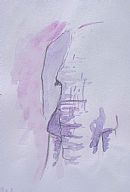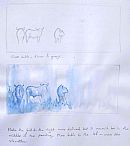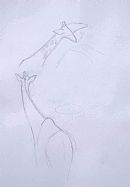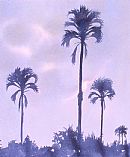 |

       
 

Members
Login

| Join Alison in August, 2007 as she works with the Painted Dogs Conservation project and studies Painted Dogs in-situ at Hwange National Park in Zimbabwe.
Find out more... |
|
|

|
|
| |

 |
 |
Sketches from Botswana
The following images are sketches from Botswana.
This sketch is a favorite as I feel that it captures the expression and the bulk of a bull elephant. It was drawn in Savute, Chobe National Park.
Savute is well known for it's huge population of big bull elephants. There seems to be an elephant around every bend in the track and they make great sketching subjects because of their size, their shape and the fact that they will often stand and drink at a waterhole for lengthy periods of time. This was sketched in pencil and the watercolor was added when I returned to camp.

|

 |
 |
This sketch and the one beneath show the progression from seeing an animal and sketching in pencil to designing a potential painting. (You can click on the images to enlarge them and see all the detail.) In this image you see a couple of sketches I did of buffalo bulls on the Chobe riverfront. They were crossing back into the bush after a night grazing on the islands. I particularly liked the sketch in the top right corner and decided to use it in a future painting (see next image).

|

 |
 |
When I design a painting I close my eyes
and try to 'see' the finished piece, then I sketch it out. I took the bull from the previous sketch and made him the main focus of the painting. I also gave some thought to the colors I will use in the finished piece and, as usual, the painting contains a fairly large area empty of detail. I think this makes for a better composition and it also sybolizes the vast open spaces of Botswana which appeal to me so much. I haven't started this painting yet and may very well change the composition again but it gives you some idea of how my wildlife sightings become wildlife paintings.

|

 |
 |
The Whitebacked Vultures were feeding on a kudu killed by a leopard. They came in to land with their feet hanging low and their heads down, swooping onto the ground and bouncing to a halt.

|

 |
 |
Giraffes are one of the species which occur everywhere in Botswana, from the dry grasslands and scrub of the Kalahari Desert to the watery channels of the Okavango Delta and the rocky Tuli Block. These sketches show the different head positions of a browsing male. I really liked the simple shapes of the giraffe at the bottom of the page.

|

 |
 |
While sketching this male cheetah in Savute I didn't realise this beautiful cat was in deep trouble. He was lying next to a female (probably his sister) but as he got up to move further into the shade I saw that his left shoulder was dislocated. Even if the female can hunt for them both, this injury is likely to prove fatal as it won't heal. It will also be difficult to avoid the numerous lions in the area, who will almost certainly kill any cheetah they can catch. It is a shame to see an injured animal, especially an endangered species like this cheetah, but it is a reminder that for a predator, just like every other animal, life is tough and survival is
not certain.
***************

|
_by_Alison_Nicholls.jpg)
 |
 |
Duma (watercolor 10" x 12")
The following images and text explain my painting process in the studio, which is totally different to my 'on location' safari sketches. In the studio I can stretch my watercolor paper and control the drying time of watercolor washes. I also like to eliminate unnecessary detail from my finished paintings and I find this easier to do when I am away from the hustle and bustle of the bush.

|
_by_Alison_Nicholls.jpg)
 |
 |
Broken Tusk (watercolor 19" x 27")
Every painting begins with an image created in my mind’s eye. I only paint wildlife I have seen in it's natural habitat so collectors can be sure my paintings are based on personal experience and are not a reproduction of a photograph. Usually I begin a new painting by mentally walking back into a particular landscape. I ‘see’ the area, the birds and wildlife but I also hear the sounds (deep thunder rumbling over the Kalahari), smell the smells (the wonderful dusty tang of rain in the air) and feel the sensations (the hot winds of late summer). Generally I come up with a concept for a new painting while I’m out walking my German Shepherd dog. I find I need to be out of the studio so I can clear my mind of any distracting images. I must admit that it can be quite bizarre walking in a snow covered park in New York while in my mind’s eye I see elephants taking an evening drink from the Chobe river!

|
.jpg)
 |
 |
Running from the Rain (watercolor 12" x 12")
Once I have the concept I work on the composition. This involves drawing numerous smallscale (“thumbnail”) pencil sketches. I try to incorporate movement but I also try to paint wildlife acting naturally, oblivious to my presence. This crucial composition stage can make or break the painting - if a composition is good you probably won’t notice it but if it is bad it will hit you like a brick between the eyes.

|
.jpg)
 |
 |
Eyes on Africa (watercolor 16" x 26")
When the composition is decided I can begin to paint. Sometimes all goes well and the piece seems to paint itself (these are days when I smile a lot). Other times a painting seems doomed from the first brush stroke and I know it is destined for the scrap paper pile (these are days when I scowl a lot and my husband knows not to delve too deep into my studio). In the past I quickly abandoned any painting which wasn’t going according to plan, rejected the idea and moved on to a new subject. Nowadays if I feel a painting is not living up to my expectations I often violently overwork it and sometimes end up with a fantastic success. Even if it cannot be saved I am now able to see these pieces not as failures but as practice. As an artist friend of mine pointed out: "Everyone knows that a musician has to practice playing a piece of music many times to get it right, why should art be any different?" Painting is like anything else in life – a natural 'talent' can certainly help but to be really good you have to work at it.

|

 |
 |
Palms at Dusk (watercolor)
Frequently people assume that I must paint from photographs because I am painting African wildlife while living in New York. It's a strange thing to try and explain but Africa is crystal clear in my mind. I lived in Zimbabwe and then Botswana for nearly nine years and I have no trouble 'seeing' a specific place in my mind's eye. I have also spent many hours watching and sketching wildlife so there are certain animals (elephants are an example) that I can happily draw and paint without reference to any photograph. Of course I do have a huge collection of great slides and I do refer to them if I need to check a detail for a painting but they do not dictate my subject matter.

|
.jpg)
 |
 |
Stormy Skies (watercolor 12" x 12")
I paint Africa and African wildlife because that is what inspires me to pick up a brush. The landscapes and wildlife are indelibly etched in my mind. Every dusty hour spent watching elephants, every calm mokoro trip through the lilies of the Okavango Delta, every pale dawn spent listening to distant lions, every Kalahari night covered in stars and every long sandy road traveled in a hot vehicle – these are all part of my experience of Africa and they form the backdrop to every single one of my paintings.

|
|
|
|
| |
 |
|
|
 |
 |
|

|
|